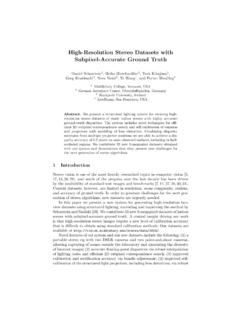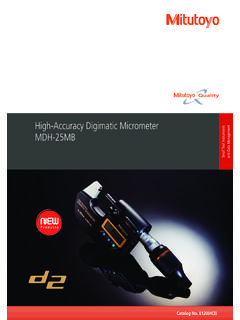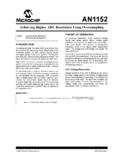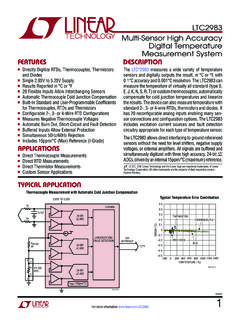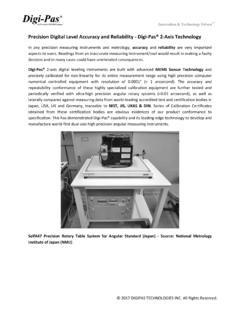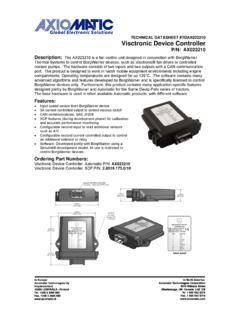Transcription of High-Resolution Stereo Datasets with Subpixel …
1 High-Resolution Stereo Datasets withSubpixel- accurate Ground TruthDaniel Scharstein1, Heiko Hirschm uller2, York Kitajima1,Greg Krathwohl1, Nera Ne si c3, Xi Wang1, and Porter Westling41 Middlebury College, Vermont, USA2 German Aerospace Center, Oberpfaffenhofen, Germany3 Reykjavik University, Iceland4 LiveRamp, San Francisco, present a structured lighting system for creating High-Resolution Stereo Datasets of static indoor scenes with highly accurateground-truth disparities. The system includes novel techniques for effi-cient 2D Subpixel correspondence search and self-calibration of camerasand projectors with modeling of lens distortion. Combining disparityestimates from multiple projector positions we are able to achieve a dis-parity accuracy of pixels on most observed surfaces, including in half-occluded regions.
2 We contribute 33 new 6-megapixel Datasets obtainedwith our system and demonstrate that they present new challenges forthe next generation of Stereo IntroductionStereo vision is one of the most heavily researched topics in computer vision [5,17, 18, 20, 28], and much of the progress over the last decade has been drivenby the availability of standard test images and benchmarks [7, 14, 27, 28, 30, 31].Current Datasets , however, are limited in resolution , scene complexity, realism,and accuracy of ground truth. In order to generate challenges for the next gen-eration of Stereo algorithms, new Datasets are urgently this paper we present a new system for generating High-Resolution two-view Datasets using structured lighting, extending and improving the method byScharstein and Szeliski [29].
3 We contribute 33 new 6-megapixel Datasets of indoorscenes with Subpixel - accurate ground truth. A central insight driving our workis that High-Resolution Stereo images require a new level of calibration accuracythat is difficult to obtain using standard calibration methods. Our Datasets areavailable features of our system and our new Datasets include the following: (1) aportable Stereo rig with two DSLR cameras and two point-and-shoot cameras,allowing capturing of scenes outside the laboratory and simulating the diversityof Internet images; (2) accurate floating-point disparities via robust interpolationof lighting codes and efficient 2D Subpixel correspondence search; (3) improvedcalibration and rectification accuracy via bundle adjustment; (4) improved self-calibration of the structured light projectors, including lens distortion, via robust2 Scharstein, Hirschm uller, Kitajima, Krathwohl, Ne si c, Wang, Westling(a)(b)(c)(d)Fig.
4 And shaded renderings of a depth map produced by our system; (a), (b)detail views; (c) resulting surface if disparities are rounded to integers; (d) resultingsurface without our novel Subpixel and self-calibration selection; and (5) additional imperfect versions of all Datasets exhibit-ing realistic rectification errors with accurate 2D ground-truth disparities. Theresulting system is able to produce new Stereo Datasets with significantly higherquality than existing Datasets ; see Figs. 1 and 2 for contribute our new Datasets to the community with the aim of providing anew challenge for Stereo vision researchers. Each dataset consists of input imagestaken under multiple exposures and multiple ambient illuminations with andwithout a mirror sphere present to capture the lighting conditions.
5 We provideeach dataset with both perfect and realistic imperfect rectification, withaccurate 1D and 2D floating-point disparities, Related workRecovery of 3D geometry using structured light dates back more than 40 years[3, 4, 25, 32]; see Salvi et al. [26] for a recent survey. Applications range fromcultural heritage [21] to interactive 3D modeling [19]. Generally, 3D acquisitionemploying active or passive methods is a mature field with companies offeringturnkey solutions [1, 2]. However, for the goal of producing High-Resolution stereodatasets, it is difficult to precisely register 3D models obtained using a separatescanner with the input images. Existing two-view [7] and multiview [30, 31] stereodatasets for which the ground truth was obtained with a laser scanner typicallysuffer from (1) limited ground-truth resolution and coverage; and (2) limitedprecision of the calibration relating ground-truth model and input images.
6 ToHigh- resolution Stereo Datasets with Subpixel - accurate Ground Truth3 Bicycle2 PlayroomPipesPlaytableAdirondackPianoNew kubaHoopsClassroom2 StaircaseRecycleDjembeFig. views and disparity maps for a subset of our new Datasets , including arestaging of the Tsukuba head and lamp scene [24]. Disparity ranges are between200 and 800 pixels at a resolution of 6 the second problem Seitz et al. [30] align each submitted model via ICPwith the ground-truth model before the geometry is evaluated, while Geiger etal. [7] recently re-estimated the calibration from the current set of ground-truth disparities from the input views directly avoidsthe calibration problem and can be done via unstructured light [1, 6, 34], butonly yields disparities for nonoccluded scene points visible in both input and Szeliski [29] pioneered the idea of self-calibrating the structuredlight sources from the initial nonoccludedview disparities, which yields registeredillumination disparitiesin half-occluded regions as well.
7 We extend this idea inthis paper and also model projector lens distortion; in addition, we significantlyimprove the rectification accuracy using the initial and Nayar [10] achieve Subpixel precision using a small number ofsinusoidal patterns, but require estimating scene albedo, which is sensitive tonoise. In contrast, we use a large number of binary patterns under multipleexposures and achieve Subpixel precision via robust interpolation. We employthe maximum min-stripe-width Gray codes by Gupta et al. [9] for improvedrobustness in the presence of interreflections and , we argue that the approach of [29] is still the best method for ob-taining highly accurate ground truth for Stereo Datasets of static scenes.
8 Thecontribution of this paper is to push this approach to a new level of addition, by providing Datasets with both perfect and imperfect rectification,we enable studying the effect of rectification errors on Stereo algorithms [13]. InSection 4 we show that such errors can strongly affect the performance of High-Resolution Stereo matching, and we hope that our Datasets will inspire novel workon Stereo self-calibration [11].4 Scharstein, Hirschm uller, Kitajima, Krathwohl, Ne si c, Wang, WestlingCalibration imagesAmbient imagesCode imagesinitial calibrationimperfect calibrationdecoding, interpolation2D matchingmergingbundle adjustmentperfect calibrationrectificationdecoding, interpolation1D matchingmergingself-calibr., reprojection1D view disparities1D illum.
9 Disparitiesmergingwarping2D view disparitiesmerged 2D disparitiesmerged 1D disparitiesPerfectdisparitiesImperfect disparitiesrectificationPerfect ambientsrectificationImperfect ambientsFig. of the overall processing Processing pipelineThe overall workflow of our 3D reconstruction pipeline is illustrated in Fig. inputs to our system are (1) calibration images of a standard checker-board calibration target; (2) code images taken under structured lighting fromdifferent projector positions; and (3) ambient input images taken under differ-ent lighting conditions. The main processing steps (rows 2 4 in Fig. 3) involvethe code images taken with the two DSLR , the original (unrectified) code images from each projector are thresh-olded, decoded, and interpolated, yielding floating-point coordinates of the pro-jector pixel illuminating the scene.
10 These values are used as unique identifiersto establish correspondences between the two input views, resulting in Subpixel -accurate2D view disparities, which are used in a bundle-adjustment step torefine the initial imperfect calibration. The processing then starts over, takingrectified images as input and producing1D view disparities(row 3 in the dia-gram). The merged disparities are used to self-calibrate each projector (row 4),from which1D illumination disparitiesare derived. All sets of view and illumi-nation disparities are merged into the final perfect disparities, which are thenwarped into the imperfect rectification. Corresponding sets of ambient imagesare produced by rectifying with both calibrations (row 5). We next discuss theindividual steps of the processing pipeline in acquisition:To capture natural scenes outside the laboratory we employa portable Stereo rig (Fig.)
